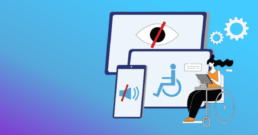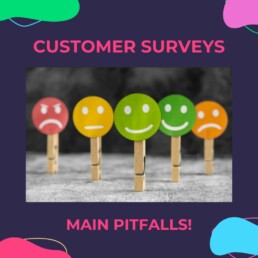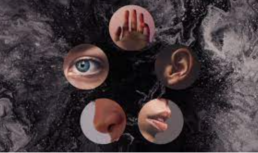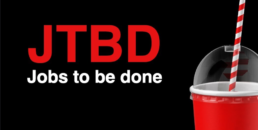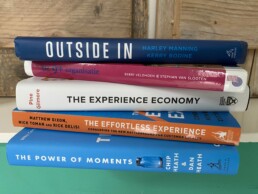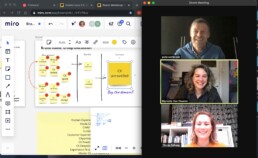Inclusive CX: Bridging the Gap through Accessibility
Did you know that 15% of the world population has some form of disability? And did you know that 1 out of 12 males and 1 out of 200 females are probably unable to distinguish the red and green dots in this posts visual?
Some form of disability includes: motor impairment, low literacy, slight mental handicap, dyslexia, color blindness, visual and auditive impairment
Have you ever stepped in the shoes of these customers? Do you specifically design your products and services for these customers?
Accessible design is focused on ensuring that interfaces and technology can be used by people with disabilities. We recently hosted a @womenincx event on this topic and if the participants were representative for most companies, then you've either just embarked on desigining for accessibility or have a desire to do so. Which is good news!
But where to start?
There are tons of great resources on the internet, but there are also some great books out there worth reading:
* Accessibility for Everyone by @Laura Kalbag
* A Web for Everyone by @Sarah Horton and @Whitney Quesenbery
* Designing Across Senses by @Christine Park and John Alderman
Let us know which other resources you know which are worthwhile to share with anyone looking to move forward on designing for accessibility!
Must reads to supercharge your CX knowledge
Summer's in full swing, and you know what that means – it's time to level up your customer experience game! Whether you're chilling on the beach or sipping a cool drink by the pool, here are the 5 must-reads to supercharge your CX knowledge this season! 📚🏖️
* Why Your Customer Experience Program Will Fail by Friederike Niehoff and Aleksandra Pilniak. 93% of all CX programs fail. Read this book to understand what you need to do to make it to the 7% that is successful.
* The Digital-First Customer Experience by Joe Wheeler. Digital-first is an important trend in CX and based on real-life cases, this books helps you design the right digital-first experience.
* Built to Win by Annette Franz, CCXP. Looking to read up on Customer-Centric Culture? Look no further! How to transform your existing company culture and rebuild it around the needs of your customers.
* Never Lose an Employee Again by Joey Coleman. This list would not be complete without a book on Employee Experience (EX). Including practical strategies that will teach you exactly how to recruit top talent, bring them on board successfully and keep them engaged.
* And in the Design category: This is a Prototype by Scott Witthoft and Stanford University Institute of Design / d.school. Definitely read this if you want to become better at prototyping.
Happy reading! 📚
7 things we can learn from Coldplay!
Even when expectations (and prices) are sky high ...
Coldplay still keeps amazing and delivering an unrivalled experience in so many ways that other artists (and companies) can only dream of!
OK, there is this amazing show, 2 hours of songs you can sing and dance along with, perfect live performance and a visual experience you don't see anywhere else!
But what else stood out:
7 things we can learn from Coldplay!
1. Being authentic
Chris Martin is Chris Martin. What you see is what you get. You feel he genuinely cares. Everything he does is real, from having fun on stage to improvising and talking to his fans and showing his appreciation for his other band members.
2. Staying positive
Not only with catchy songs and confetti and fireworks but also when it starts raining at the beginning of the concert. He just keeps smiling and starts singing:
I have been in Paris, I have been in Spain
but nothing beats Amsterdam in the rain!
3. Making a personal 1-1 connection
When inviting a girl on stage who asks him to sing the song FLY ON for her brother in heaven. Clearly improvising, making apologies to her and her brother for making some keyboard mistakes, and asking her to sing along with him while looking up together to heaven
4. As well as connecting to all 60.000 people
By asking visitors to put away their cameras for a moment, pointing out that this is a very special moment: we will never be together with these 60.004 people. And we take the next 3 minutes to enjoy it together to the max! And what a difference it makes: 60.000 fans (from 5 to 75 years old) jump to the tunes of A sky full of stars! and experience the moment!
5. Valuing customers for their business
Thanking fans various times throughout the evening for coming to the show, for travelling and taking all the effort to see the concert. And giving attention to ALL visitors, not only to those in the front, but playing a part of the concert on the other side of the stadium so people in the back get the best seats for a part of the concert.
6. Contributing to a better planet
Before starting the show, pointing out all their efforts and achievements in the area of sustainability (and there are too many to mention); walking around with a rainbow flag and supporting the LGBT community; and asking everyone to keep spreading love
7. In the end ... Making it memorable
It is Friday; the concert was on Tuesday and the experience is still in my memory and here to stay.
OK, we are not Coldplay, but if we take at least one of the above points with us, we are sure this will lead to delivering better experiences for all of us!
Customer Surveys - Main Pitfalls
A good customer understanding can be seen as the cornerstone of customer experience. Customer surveys are by far the most used tool to get customer feedback. And while these surveys hold immense potential for understanding customer preferences and improving products or services, they are not without their pitfalls. Here we share some pitfalls every business should be aware of before sending out a customer survey:
1. Survey Fatigue
There are too many surveys with too many questions. An access of surveys can lead to low response rates and rushed and inaccurate responses.
2. Surveys dissatisfy customers
Surveys are often the last touchpoint in the customer journey. If you ask irrelevant questions, it might annoy your customers, leaving a negative last impression of your brand.
3. The wrong customers answers
If surveys are only sent to or being answered by a specific group of customers, the data collected may not be representative of the entire customer base. This can lead to skewed insights and misguided decisions.
4. The wrong questions are asked
Leading, irrelevant or misunderstood questions, lack of context, limited response options; making a good questionnaire is a profession! Asking the wrong questions can lead to unactionable date, the wrong insights and decisions.
5. No follow up is given
Although almost all companies collect some form of customer feedback, just a small percentage structurally puts it into action and closes all feedback loops! Some surveys are just marketing campaigns in disguise and only have the objective to show the outside world how good the company is doing.
6. Gaming and manipulation
If employee rewards depend on customer survey scores, you will have the risk that surveys will only be shared with happy customers or customers will even be asked to rate a 9 or 10. The metric itself becomes the target, not the improvement of customer insight or the customer experience.
Create emotional engagement with your customers: stimulate the five senses
In previous journey mapping sessions we have done with our clients, we look at the main journey phases and always map at least three elements: the customer needs, customer actions (what they do) and customer emotions (how it makes them feel). Zooming in on the emotions is an effective way to see where to take action to improve the experience. This can be done by fixing pain points or by creating extra value points. From there we go to find the best solutions: the ones that create maximum customer value at a relatively low implementation effort for the organization. Quite straightforward.
So far, this is nothing unusual. But not every company consciously looks at their journey to see where they can stimulate the right human senses. We think this could or rather, should be a very relevant part of every journey mapping exercise.
Why is stimulating the senses important?
Science shows that by stimulating the senses, you will appeal to what is known as the customer’s first brain. This brain is the oldest brain; it has been around there for 500 million years, and it is common among most animals. It is primitive and emotional! It manages the unconscious thoughts and plays an essential role in the overall customer experience and how it makes customers feel.
How to stimulate the senses?
There are numerous examples of the use of senses in retail environment, hospitality, and airline industry. I am going to give you some examples used in the airline industry, of course it can be applied to any industry where there is physical contact between the company and its customers.
Sight
Customers depend more on sight than on any other senses to navigate through a physical environment. At first glance, a first impression is formed. When you enter an aircraft of Virgin Atlantic, you don’t have the feeling that you are walking through a working area for crew with containers, like with most airlines. No, next to a welcoming crew, you see a nice bar and the right lighting that sets a comfortable mood. This nice atmosphere makes you feel relaxed. Suddenly you are looking forward to your 10 hour flight.
Hearing
Sound, especially music, can bring the visual world to life and can bring back memories. Virgin played poppy music from Blondie to Kylie Minogue and David Guetta. Delta Airlines played Pharell William’s Happy during boarding and disembarking the aircraft. It works both ways: when you hear the music on board, it stimulates a positive mood. And when you hear it back home, it might bring back Delta memories.
Smell
Smell is a powerful sense. It is the strongest trigger of emotional memory. I am sure if you smell the perfume that your mother used many years ago, it will bring you back to your childhood. Airlines also invest in scent marketing. Since the 1990s, Singapore Airlines has created its own fragrance as its scent brand. But it can be applied in other ways: Delta Airlines was famous for serving chocolate chip cookies on board. By heating them, the whole cabin could smell it and long for the upcoming treat.
Taste
Free tasting options are used at many food courts, as it increases the overall sales. But also outside of the food business you can use it. Some airlines offer free cookies in baggage reclaim areas, managing perception about waiting times. And seen from a different perspective: as your taste on board of an aircraft is different than on the ground, it brings some extra challenges to provide tasty meals and good tasting (not too acid) wines on board.
Touch
Touching something moves it from a representation / an idea to something true. Although with Covid-19 this has changed, instinctively people want to touch something to get a better idea of it or to check or experience the quality. You choose to use what you enjoy touching! For airlines, attention is now being paid to high quality amenities and good bed linen in First Class cabins.
So what can this mean for you your company and your customers?
Have a look at your company’s customer journey and see where you trigger which senses
- Where in the journey does your customer see, hear, smell, taste or touch?
- Which emotional reactions does and/or can it trigger?
- Does it enhance the customer experience? Or could it have negative impact?
Both in general as well compared to your desired experience and brand positioning?
Want to know more on how to trigger your customer’s senses and improve the emotional engagement? And how to embed this in your journey mapping exercise? Please contact us at hello@cxunraveled.com
Jobs to be done
What do your customers really want? What is their Job to be Done?
In Customer Experience it is essential to know what your customers really want. How else can you be sure you can meet or even exceed their expectations? In order to be sure, you need t o clearly define what your customers are trying to achieve; in other words: what is their job to be done when they interact with your company?
Why do customers buy a product or service? They want to hire you or use your product to get a job done! A well-known example is that a person buys a drill not because they want a drill, but because they are looking for a solution to get their job done: to get a hole in a wall to put up a painting!
Another example is that people aren’t looking to buy navigation apps, but need to get to their destination on time and the easiest solution to the task at hand, is a map or car radio or an app. Consider even listening to music to feel good! I’ve have had this “job” my entire life and yet I’ve used different solutions to get this job done over the years, from radio to vinyl records to CDs to iPods to now streaming music.
These examples tell us the 5 key elements of jobs to be done:
- They tell you what your customer really wants to achieve
And to achieve this, they need to hire a product or service to get their job done - These Jobs remain stable over time
They are mostly core needs that don’t change that quickly - Jobs are independent of the solution
A job is never a product or solution!
And as soon as a better solution comes in the market, then this solution takes over from the previous solution to get the job done - Jobs often fix a problem or solve a challenge
It helps to think of your customer’s frustrations to find out what problem or challenges they try to solve to think about jobs to be done - Jobs can be different in scope
- Jobs can be small or big; a small job could be that you want to pass some time during your lunch break (and to get that job done you might be reading this blog); a big job could be that you are looking for a career switch to Customer Experience (and to get that job done you might be reading this blog) > same solution for different jobs
- Jobs can be functional or emotional: a functional job could be that you want to drive safely and fast from A to B (and to get that job done you might buy a Tesla); two emotional jobs could be that you want to impress your friends, or maybe contribute to a greener planet (and to get those jobs done you might buy a Tesla) > again, the same solution for different jobs
Only companies that define their markets in jobs to be done, will survive! If you define your market in products, then you are working with a moving target. This will lead to failure. For examples of failures think of Blackberry who was in the markets of keyboard mobile devices, and Kodak who was in the market or film. These were not jobs to be done. Tech giants like Apple and Facebook knew the real jobs to be done: connect to other people and sharing memories > they came with the right solutions to meet those jobs.
We hope this clarifies and makes you think about jobs to be done instead of products. In a next blog we will come up with more examples and provide an easy template that helps you define your own jobs to be done! So… if your job to be done is to clearly define what your customers really want, then our next blog might be the solution you are looking for. Stay tuned!
CX must-reads!
CX must-reads!
It’s good to see you reading my blog! It means that you would like to further deepen your knowledge about Customer Experience (CX) and I promise you it will be a lot of fun. Quite some people have asked me for book recommendations with more information & inspiration on CX. That’s why I’ve created this list of my Top 5 favorite CX books.
- Outside In by Harley Manning and Kerry Bodine. A golden oldie (published in 2012). But this Forrester Research duo has managed to explain the six disciplines of CX in a very digestible way: strategy, customer insights, human centered design, CX metrics, customer centric organization and a customer obsessed culture. Plus it’s full of inspiring real-life examples.
- De 9+ organisatie. Van marketshare naar mindshare by Berry Veldhoen & Stephan van Slooten. This one is for Dutchies only (sorry!), that is – until Berry & Stephan publish an English version. Berry & Stephen were pioneers in the CX field in The Netherlands and work together at Customer & Employee Experience Consultancy firm Altuition. They have combined their CX experiences in this book, which describes what companies should do if they want to create a great customer experience: (1) figure out what’s relevant from the customer’s perspective, (2) create & do new things which make the difference in the emotions and experience of the customer and (3) organize these new things systematically as part of their total service & proposition package.
- The Experience Economy by Joseph Pine II and James H. Gilmore. Another golden oldie (their original article was published in 1998), but if you order the 2020 edition you’ll find a brand new foreword with recent practical examples. This book explains how we’ve moved from commodities to goods to services to experience. It also gives plenty of inspiration on how you can create brilliant experiences in your own context.
- The Effortless Experience by Matthew Dixon, Nick Toman en Rick Delisi. A refreshing book in this top 5, because these gentlemen are definitely not about creating “WOW-moments” of so-called “customer delight”. Simply solve your customers problems in a quick & easy way! There’s definitely some sense in that (as their research shows) – especially for company departments such as customer service.
- Last but not least, The Power of Moments written by brothers Chip & Dan Heath. In this book the mystery of experience is slowly unravelled – why, for example do we remember the best and worst moments of an experience and forget the rest? A psychological take on customer experience, supported by great practical examples.
I’m super curious of your opinion on these books and would love to hear if you think other CX books should be added to this list. Have fun reading!
The Making Of, Part 1
The Making Of, Part 1
What do you get when you put three Customer Experience Fanatics together…. so much enthusiasm about sharing their passion that they decide to start their own company! So we took upon ourselves the challenge of creating better life experiences by combining our forces with this huge amount of information on CX. But where to start and how to unravel.... 😆
How do we inspire people to become advocates for CX as well? How do we share our knowledge and expertise, and motivate and activate people at the same time?
As CX professionals we of course first took into account our customers needs. We can imagine that our customers have heard about Customer Experience but do not know where to start practicing it. Or they already work in the field and would like to learn more. Or their company is in need of structured CX implementation. Bottom line, there is so much information available and it is all linked to each other and intertwined. It might even be chaotic, discovering how to unravel all of this and finding your own way to bring it into practice.
Well that is exactly where we want to step in. Yes we are the No Guts No Glory kinda group, who want to make our passion your passion as well. We not only want to share our knowledge and expertise, we love to share it with you in a fun and practical way. We are interested in your CX journey and how we can help with a personalized track. We also challenge you to think out of the box and put into practice tomorrow what you learned from us today. Do you see some brand values in this text already…?
Haha now how to translate this into a brand name… well we went through a whole process of aligning, connecting, philosophizing, dreaming, evaluating, researching and feeling. We love to work in MIRO, an online collaboration tool. And with the help of the template https://miro.com/miroverse/minimum-viable-brand-workshop/ We finally decided on CX UNRAVELED. In the picture you see this very special moment!
